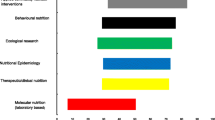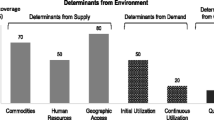Abstract
Background
Despite scientific evidence on the potential impact or importance of specific interventions to improve micronutrient status of vulnerable groups, political commitment and extensive support from national stakeholders is paramount to support introduction and implementation of these interventions at national level. In order to develop efficient nutritional strategies to improve the micronutrient status of children < 5 years of age and women of reproductive age that will be supported by a wide range of stakeholders, a better understanding of viewpoints on the nutrition politics and strategies is necessary. Multi-criteria mapping (MCM) was successfully used to assess the stakeholder’s viewpoint in a wide variety of contexts since the late 1990s.
Objective
The objective of the present study was to assess the viewpoints of stakeholders on a wide range of potential nutritional interventions in the five Southeast Asian countries participating in the SMILING project.
Method
MCM methodology was used to appraise the stakeholder’s viewpoints in five countries.
Results
The results show that the overall stakeholders’ preference was for actions already implemented in their country rather than for new, innovative options, even for supplementation. Indirect interventions such like food fortification (except in Indonesia), delayed cord clamping or food-based approaches were generally less favored by the stakeholders. However, the majority of stakeholders agreed that new approaches should be considered and put in place in the future provided that evidence of their impact was demonstrated, that they received adequate technical support for their implementation and their monitoring, and that they will be accompanied by strong advocacy among decision-makers, civil society and beneficiaries.
Conclusions for practice
To conclude, for the introduction of new, innovative strategies to reduce micronutrient deficiencies in South-East Asia, convincing stakeholders appears to be the first hurdle to be taken.


Similar content being viewed by others
References
Allen, L. H., Peerson, J. M., & Olney, D. K. (2009). Provision of multiple rather than two or fewer micronutrients more effectively improves growth and other outcomes in micronutrient-deficient children and adults. The Journal of Nutrition, 139(5), 1022–1030.
Bhutta, Z. A., Das, J. K., Rizvi, A., Gaffey, M. F., Walker, N., & Susan, H. (2013). Evidence-based interventions for improvement of maternal and child nutrition: What can be done and at what cost? The Lancet, 382, 452–477.
Casey, G. J., Sartori, D., Horton, S. E., Phuc, T. Q., Phu, L. B., Thach, D. T., et al. (2011). Weekly iron-folic acid supplementation with regular deworming is cost-effective in preventing anaemia in women of reproductive age in Vietnam. PLoS ONE, 6, e23723.
Cavalli-Sforza, T., Berger, J., Smitasiri, S., & Viteri, F. (2005). Weekly iron-folic acid supplementation of women of reproductive age: Impact overview, lessons learned, expansion plans, and contributions toward achievement of the millennium development goals. Nutrition Reviews, 63, S152–S158.
Copenhagen Consensus Center. (2012). Copenhagen consensus 2012. Retrieved from http://www.copenhagenconsensus.com/Admin/Public/DWSDownload.aspx?File=%2fFiles%2fFiler%2fCC12+papers%2fOutcome_Document_Updated_1105.pdf.
Development Initiatives, D. (2017). Global nutrition report 2017: Nourishing the SDGs. Bristol: Development Initiatives.
Dijkhuizen, M. A., Wieringa, F. T., Soekarjo, D., Van, K. T., & Laillou, A. (2013). Legal framework for food fortification: Examples from Vietnam and Indonesia. Food and Nutrition Bulletin, 34(2 Suppl), S112–S123.
Fall, C. H., Fisher, D. J., Osmond, C., & Margetts, B. M. (2009). Multiple micronutrient supplementation during pregnancy in low-income countries: A meta-analysis of effects on birth size and length of gestation. Food and Nutrition Bulletin, 30(4 Suppl), S533–S546.
Fisher, J., Tran, T., Biggs, B., Tran, T., Dwyer, T., Casey, G., et al. (2011). Iodine status in late pregnancy and psychosocial determinants of iodized salt use in rural northern Viet Nam. Bulletin of the World Health Organization, 89(11), 813–820.
Gayer, J., & Smith, G. (2015). Micronutrient fortification of food in Southeast Asia: Recommendations from an expert workshop. Nutrients, 7(1), 646–658.
González-Zapata, L. I., Ortiz-Moncada, R., & Alvarez-Dardet, C. (2007). Mapping public policy options responding to obesity: The case of Spain. Obesity Reviews, 8, 99–108.
Haider, B. A., & Bhutta, Z. A. (2017). Multiple-micronutrient supplementation for women during pregnancy. Cochrane Database of Systematic Reviews, 4, CD004905.
Holdsworth, M., Delpeuch, F., Kameli, Y., Lobstein, T., & Millstone, E. (2010). The acceptability to stakeholders of mandatory nutritional labelling in France and the UK—Findings from the PorGrow project. Journal of Human Nutrition and Dietetics, 23(1), 11–19.
Holdsworth, M., Kameli, Y., & Delpeuch, F. (2007). Stakeholder views on policy options for responding to the growing challenge from obesity in France: Findings from the PorGrow project. Obesity Reviews, 8, 53–61.
Holdsworth, M., Kruger, A., Nago, E., Lachat, C., Mamiro, P., Smit, K., et al. (2015). African stakeholders’ views of research options to improve nutritional status in sub-Saharan Africa. Health Policy and Planning, 30(7), 863–874.
Laillou, A., Pham, T. V., Tran, N. T., Le, H. T., Wieringa, F., Rohner, F., et al. (2012). Micronutrient deficits are still public health issues among women and young children in Vietnam. PLoS ONE, 7(4), e34906.
Laillou, A., Sophonneary, P., Kuong, K., Hong, R., Un, S., Chamnan, C., et al. (2016). Low urinary iodine concentration among mothers and children in Cambodia. Nutrients, 8(4), 172.
Lubogo, D., & Orach, C. G. (2016). Stakeholder perceptions of research options to improve nutritional status in Uganda. BMC Nutrition, 2(1), 26.
Mayer, S., & Stirling, A. (2002). Finding a precautionary approach to technological developments—Lessons for the evaluation of GM crops. Journal of Agricultural and Environmental Ethics, 15(1), 57–71.
Ramakrishnan, U., Aburto, N., McCabe, G., & Martorell, R. (2004). Multimicronutrient interventions but not vitamin a or iron interventions alone improve child growth: Results of 3 meta-analyses. The Journal of Nutrition, 134(10), 2592–2602.
Savva, S. C., Chadjioannou, M., & Tornaritis, M. J. (2007). Policy options for responding to the growing challenge from obesity: Cyprus national findings. Obesity Reviews, 8, 37–45.
Stirling, A. (2005). Multi-criteria mapping: A detailed analysis manual. Version 1.
Stirling, A. (2015). Multicriteria mapping manual—Version 1.2.
Stirling, A., & Mayer, S. (2001). A novel approach to the appraisal of technological risk: A multicriteria mapping study of a genetically modified crop. Environment and Planning C: Government and Policy, 19(4), 529–555.
Thurlow, R. A., Winichagoon, P., Pongcharoen, T., Gowachirapant, S., Boonpraderm, A., Manger, M. S., et al. (2006). Risk of zinc, iodine and other micronutrient deficiencies among school children in North East Thailand. European Journal of Clinical Nutrition, 60(5), 623–632.
Wieringa, F. T., Dahl, M., Chamnan, C., Poirot, E., Kuong, K., Sophonneary, P., et al. (2016). The high prevalence of anemia in Cambodian children and women cannot be satisfactorily explained by nutritional deficiencies or hemoglobin disorders. Nutrients, 8, 348.
Yearley, S. (2001). Mapping and interpreting societal responses to genetically modified crops. Social Studies of Science, 31(1), 151–160.
Author information
Authors and Affiliations
Corresponding author
Rights and permissions
About this article
Cite this article
Greffeuille, V., Kameli, Y., Chamnan, C. et al. Multi-criteria Mapping of Stakeholders’ Viewpoints in Five Southeast Asian Countries on Strategies to Reduce Micronutrient Deficiencies Among Children and Women of Reproductive Age: Findings from the SMILING Project. Matern Child Health J 23 (Suppl 1), 67–78 (2019). https://doi.org/10.1007/s10995-018-2636-5
Published:
Issue Date:
DOI: https://doi.org/10.1007/s10995-018-2636-5




